Paige
and Mary Bess Mulhollan in May 2005
PAIGE AND MARY BESS MULHOLLAN
WATERFOWL OBSERVATION BLIND
WHERE
IS THE BLIND? HOW DO I ACCESS IT?
Access to Mulhollan Blind is from the general area of Botanical
Garden of the Ozarks (BGO). There are two parking lots just off
Crossover Road. You can reach the blind from either lot. Currently
(August 2016), you can park in the public lot at BGO and walk outside
the tall fence to the Lake Fayetteville Nature Trail, then on to the
blind. The other path starts in the south parking area: walk the
paved Lake Fayetteville Trail going west to a spot where there is
currently an opening in the woods that leads toward the blind.
Distance from parking to the blind is about 0.4-0.5 miles on either
path. Both paths are shown on a map below.
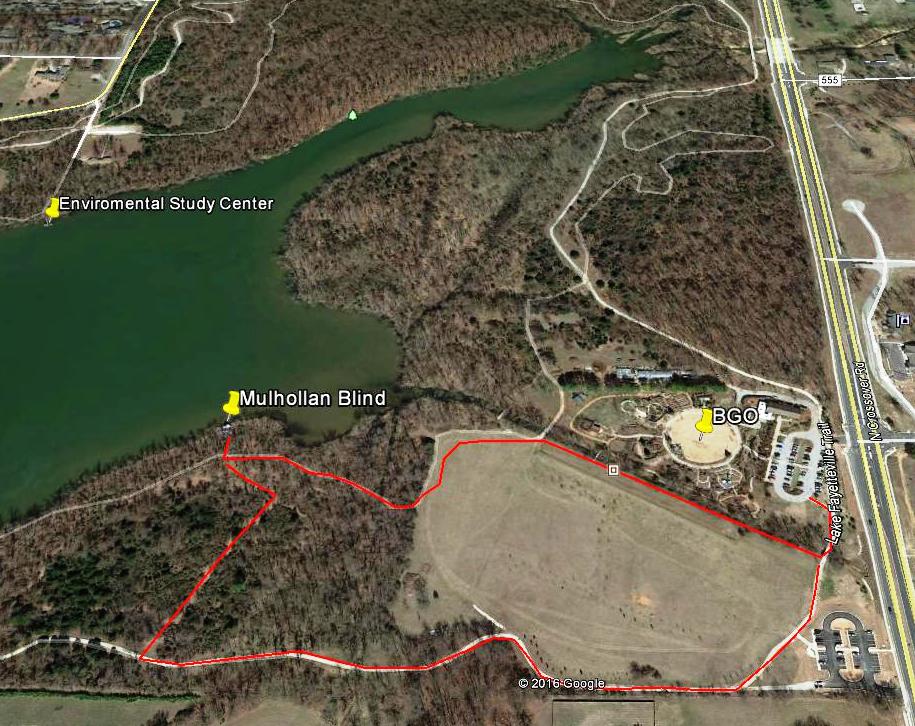
HISTORY OF MULHOLLAN BLIND PROJECT A proposal to construct a bird blind on the southern shoreline of Lake Fayetteville was approved by Fayetteville Parks and Recreation board on July 7, 2014.The blind allows visitors to closely observe the wildfowl that regularly visit this park. In recent years, watching birds has become one of the most popular hobbies in the USA and in our region Lake Fayetteville is one of the most frequently visited places for this purpose. Formal construction was completed in summer 2016.
Mulhollan
Blind across the lake from Environmental Study Center June 2016
The blind is named in honor of Paige and Mary Bess Mulhollan. Paige was at one time Director of the Botanical Garden of the Ozarks (BGO) and an avid birder who with his family participated in many activities of the Northwest Arkansas Audubon Society (NWAAS). Included in these activities have been regular field trips by the Society to Lake Fayetteville during which many unusual observations and rare bird sightings have been made.
Since 1953, when Professor Douglas James made his first trip to Lake Fayetteville, many others have visited the lake. This has resulted in reliable records of 260 bird species, testimony to the importance of Lake Fayetteville for birdlife in northwest Arkansas. The lake has been an important location for recording waterfowl on the Fayetteville Christmas Bird Count, records of which contribute to the nationwide understanding of changes in winter bird distribution.
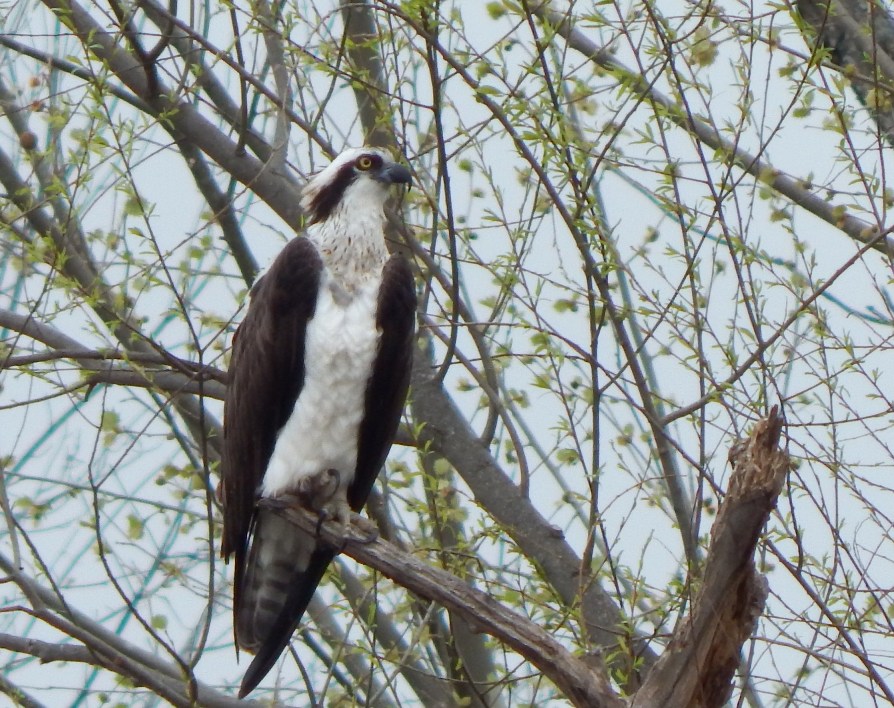
Osprey,
as viewed from Mulhollan Blind, April 10, 2016.
Ospreys
are regular migrants through Lake Fayetteville
The
blind provides an optimal way to view them without undue disturbance.
Lake Fayetteville Park is the most popular recreational area in the Fayetteville-Springdale region attracting many hundreds of people daily who participate in a great range of outdoor activities. It is also an important educational area involving both Fayetteville and Springdale school district through the activities of the Lake Fayetteville Environmental Center. The BGO also provides additional educational opportunities. Mulhollan Blind complements these missions.
In 1979, the Northwest Arkansas Regional Planning Commission classified Lake Fayetteville as a recreational complex comprising a large area of open space and a natural environment that “provides citizens contact with nature.” Mulhollan Bird Blind contributes to this vision.
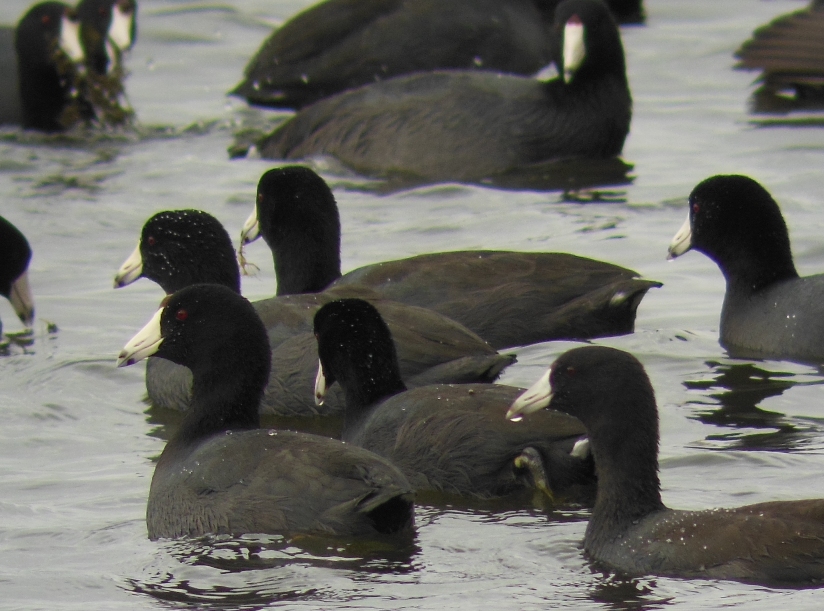
American
Coots are one of the most numerous of the water birds
seen
on Lake Fayetteville during migration and winter.
LOCATION At Lake Fayetteville, observations of water birds are best made from the south, especially in the winter months, because the sun is then behind the observer. The importance of a well-constructed and well-located bird blind is that the observer is screened from the lake, thus minimizing disturbance to any birds that may be present. During spring and fall, and also in mid-winter, flocks of waterfowl regularly occur on open water at Lake Fayetteville and during severe winter conditions they often congregate in the southern cove (opposite the BGO). The blind location takes advantage of view ability (sun behind observers), open water, the southern cove, and a relatively remote area in the park.
Mulhollan Blind is adjacent the existing nature trail, with access to the blind by a short spur leading from the trail. The blind is far enough away from the heavily-used hard top trail to minimize noise and disturbance, prerequisites for watching birds. The blind is also nestled into the woodland with minimal damage to nearby vegetation. Some shrubs, mostly invasive aliens, such as multiflora rose, privet, and Amur honeysuckle are being reduced in immediate surroundings, releasing the native vegetation including wildflowers, native sedges, and native shrubs like Swamp Dogwood and Elderberry. Panels that extend from its sides also help to screen Mulhollan Blind from the lake.
ABOUT
THE STRUCTURE Before construction, an
informal committee headed by Northwest Arkansas Audubon Society
consulted with two birders who have visited many blinds elsewhere, Dr
David Chapman and Dr Douglas James. Kelly Mulhollan brought on a
Fayetteville-based architectural designer, Michael Cockram of Bowerbird Designs,
who conducted additional research on blinds. Cockram’s design
combines aesthetic beauty and durable materials.
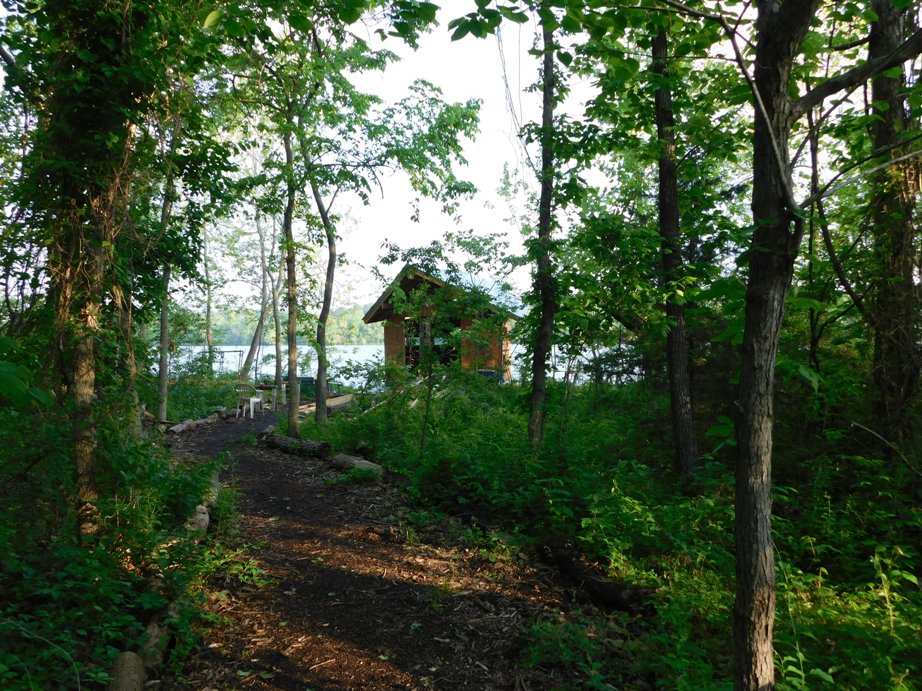
Path
to Mulhollan Blind as it leaves Lake Fayetteville Nature Trail. May
2016.
Mulhollan Blind was especially designed for the Lake Fayetteville location. The blind is of wood plank and treated timber construction with a wooden floor and mounted on a raised platform. Cedar used in construction was obtained locally. The interior of the blind contains a wooden partition screening the entrance from the viewing areas. There is bench seating with horizontal ports constructed at different levels to cater for adults and young children.
FUNDING No public tax money was expended in the construction of Mulhollan Blind, though the City of Fayetteville was helpful on several occasions for jobs requiring special equipment. Part of the work was accomplished by unpaid volunteers, including UA-Fayetteville students during “Make A Difference Day” projects. Funds were raised through private donations over two years for materials and to pay skilled carpenters Marc Gunter and Jimmy Glenn. Additional funds will be needed for future maintenance. Any donations will be gratefully received and should be sent to Bill Beall, Treasurer of Northwest Arkansas Audubon Society, 2204 Hendricks Blvd, Fort Smith, AR, 72903-3422.

Most
of the participants in the UA-Fayetteville “Make a Difference Day”
work on Mulhollan Blind on November 1, 2014.
Students
helped haul construction materials to work site.
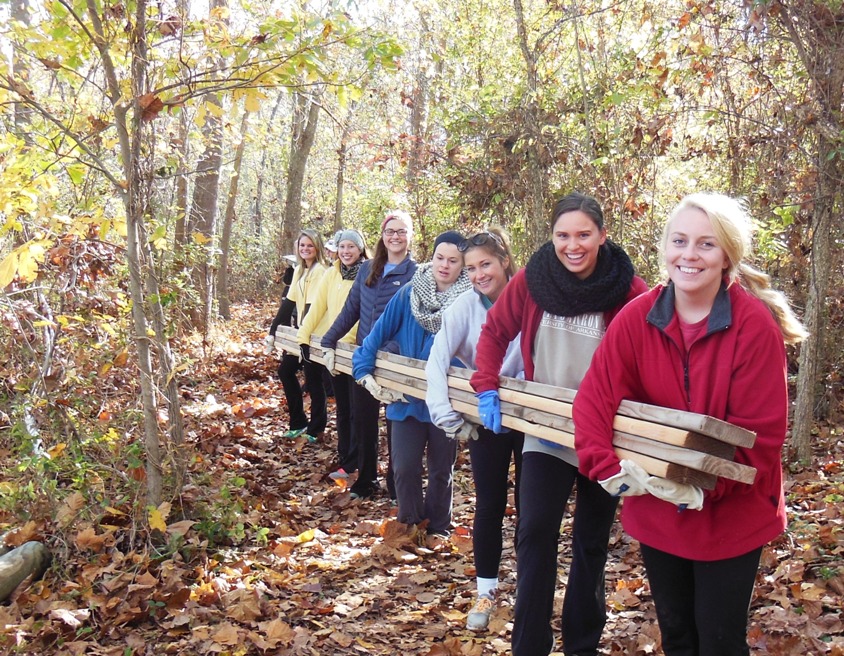
Hauling
the big timbers that were used in construction of Mulhollan Blind
platform.
UA-Fayetteville
“Make a Difference Day” work on November 1, 2014
Major financial donations (in no particular order) were given by the Mulhollan family; Northwest Arkansas Audubon Society; Fayetteville Natural Heritage Association; Doug James and Elizabeth Adam; Ozark Ecological Restoration, Inc.; an anonymous donor; Helical Concepts, Inc.; Bob and Sara Caulk; Nancy and David Felker; Botanical Garden Society of the Ozarks; and Barbara Taylor. Many donations were received, and for many, David Chapman printed and gave copies of his book, “Bird Life of Lake Fayetteville.” Approximately 50 individuals made financial donations. Thank you ALL!
Swamp
Dogwood, a common native shrub in the moist bottomlands around Lake
Fayetteville, flowering on May 29, 2016.
Preservation
of native plants is part of the Mulhollan Blind project.
PAIGE AND MARY BESS MULHOLLAN: Paige Mulhollan, a Fort Smith native and former history professor at UA-Fayetteville, was an early Director of the Botanical Garden of the Ozarks (BGO) and an avid birder. Upon retirement, he and wife Mary Bess became active in Audubon at Hilton Head Island in South Carolina, then in Fayetteville with NWAAS. He and Mary Bess also had a strong interest in butterflies. Paige was President of the Carolina Butterfly Society. Mary Bess continues these interests since Paige’s passing in 2013. Mary Bess is active in the Botanical Garden, NWAAS, and other civic organizations.
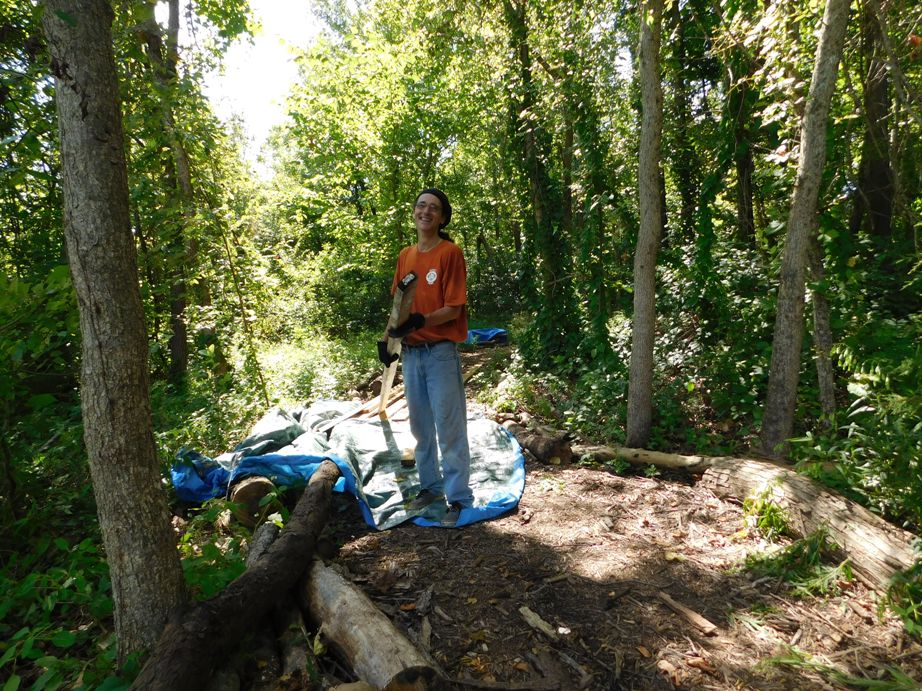
Kelly
Mulhollan, at work on the blind in July 2015.
He
is a musician (Still on the Hill) and son of Paige and Mary Bess
Mulhollan
WHO WILL USE THE BLIND? The blind is free and open to the public. We expect the Botanical Garden to make regular use of it as part of their education programs. The blind should be a magnet for birders of all ages and skills, photographers, and those who’d like this special view of the lake’s natural elements.
HOW CAN YOU HELP? NWAAS is responsible for maintenance of the blind, so additional funds will be needed for future activities. Please make checks to NWAAS with a brief note your check is for the blind. Mail to NWAAS Treasurer Bill Beall: 2204 Hendricks Blvd, Fort Smith, Arkansas, 72903-3422. He will maintain a listing of all contributions and send each contributor an acknowledgement. All gifts to NWAAS are charitable for tax purposes. If you need more information about this, contact Bill at billtoka@mynewroads.com.
Professor
H David Chapman, now retired from UA-Fayetteville, served as Chair of
the Northwest Arkansas Audubon Society blind committee. He is author
of “The History and Bird Life of Lake Fayetteville,” available in
local libraries and as a PDF here on the NWAAS website.
MORE INFORMATION ABOUT HISTORY OF LAKE FAYETTEVILLE AND BIRDS The best source of information about the history of Lake Fayetteville and in-depth details about birds can be found in H. David’s Chapman’s book, “THE HISTORY AND BIRD LIFE OF LAKE FAYETTEVILLE.” Copies of this book are available in local libraries. A PDF version is available for viewing or downloading here on the website of Northwest Arkansas Audubon Society.
STEERING
COMMITTEE David Chapman, Chair, NWAAS
Mulhollan Blind Committee; Kelly Mulhollan, Mulhollan family; Michael
Cockram, architectural designer; Joe Neal, NWAAS representing Doug James, NWAAS
president; Bob Caulk, Fayetteville Natural Heritage Association.
Bill Beall, NWAAS Treasurer, handled all financial transactions and
records.
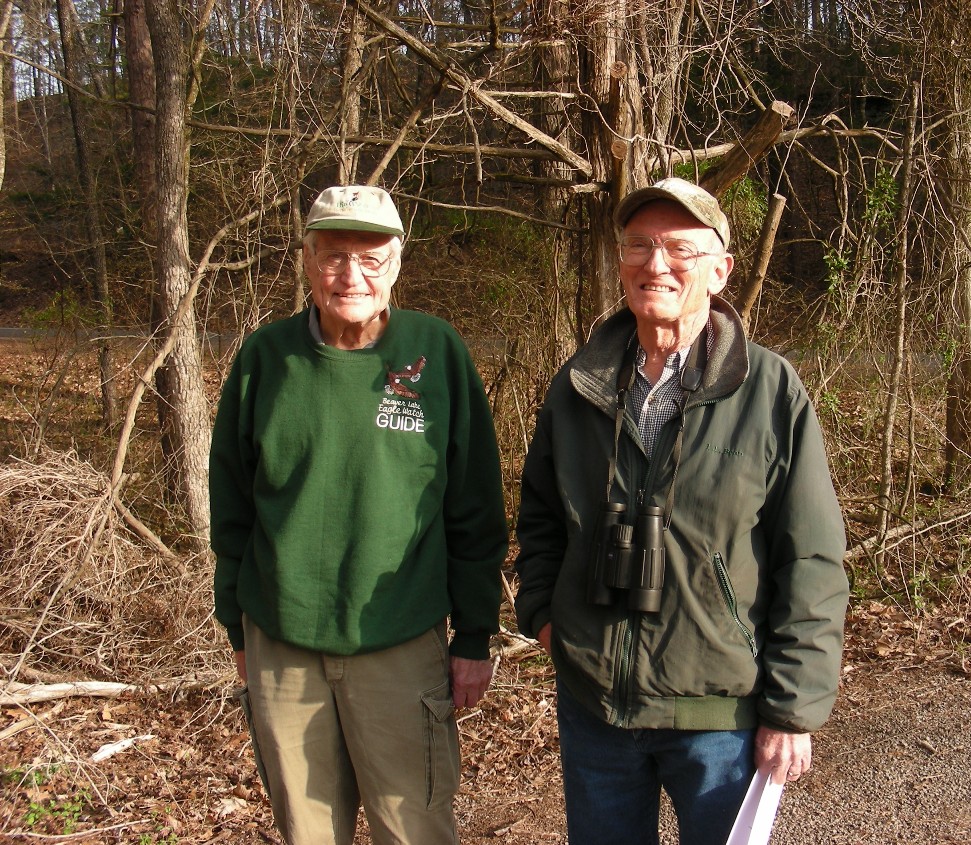
Doug
James and Bill Beall (with binoculars) in 2010.
Doug
and Bill were the first active birders at Lake Fayetteville.
Both
played important roles in the Mulhollan Blind project.
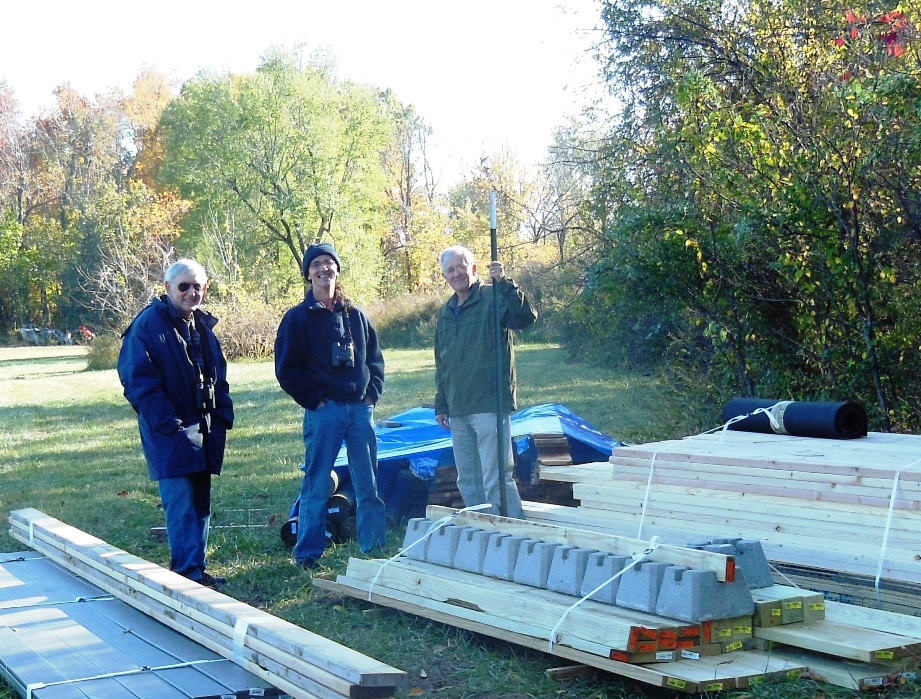
Construction
materials at Lake Fayetteville to be hauled by hand to the blind
construction site.
October
31, 2014.
Left
to right: Bob Caulk (blue coat), Kelly Mulhollan, David Chapman
___________________________________________________________________________
